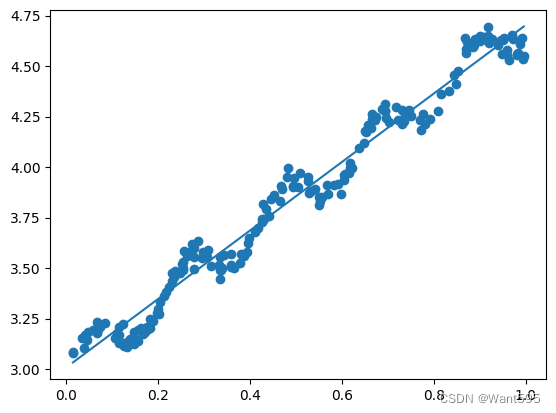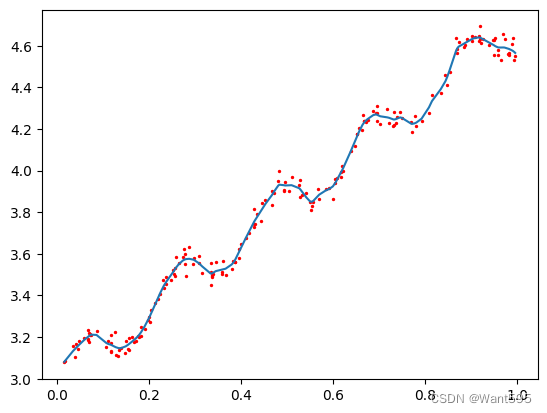- 1[译] 第九天:TextBlob - 发现字里行间的情感
- 2[Node] Node.js 包管理工具详解npm yarn cnpm npx pnpm_nodejs pnpm
- 3【Flutter】Flutter 中 sqflite 的基本使用_flutter sqflite
- 4【FPGA】Quartus项目工程创建以及联合Modelsim进行仿真(FPGA项目创建与仿真)_modelsim和quartus联合仿真
- 5数据库sql语句的exists总结
- 6基于遗传算法的模糊PID控制器整定(Matlab代码实现)_遗传算法pid整定matlab
- 7C语言经典面试题之深入解析字符串拷贝的sprintf、strcpy和memcpy使用与区别_strcpy sprintf
- 8Flink CDC 基于Oracle log archiving 实时同步Oracle表到Mysql_flink cdc oracle
- 9vue2和vue3浏览器兼容性对比
- 10一站式低代码开发平台iVX初探_android 低代码平台
Regression算法
赞
踩
用线性回归找到最佳拟合直线
from google.colab import drive
drive.mount("/content/drive")
- 1
- 2
Mounted at /content/drive
- 1
from numpy import *
- 1
def loadDataSet(fileName):
numFeat = len(open(fileName).readline().split('\t')) - 1
dataMat = []
labelMat = []
fr = open(fileName)
for line in fr.readlines():
lineArr = []
curLine = line.strip().split('\t')
for i in range(numFeat):
lineArr.append(float(curLine[i]))
dataMat.append(lineArr)
labelMat.append(float(curLine[-1]))
return dataMat, labelMat
- 1
- 2
- 3
- 4
- 5
- 6
- 7
- 8
- 9
- 10
- 11
- 12
- 13
这段代码定义了一个名为loadDataSet的函数,用于加载数据集并将其分为特征矩阵和标签向量。以下是对该函数的代码分析:
def loadDataSet(fileName):
numFeat = len(open(fileName).readline().split('\t')) - 1
dataMat = []
labelMat = []
fr = open(fileName)
for line in fr.readlines():
lineArr = []
curLine = line.strip().split('\t')
for i in range(numFeat):
lineArr.append(float(curLine[i]))
dataMat.append(lineArr)
labelMat.append(float(curLine[-1]))
return dataMat, labelMat
- 1
- 2
- 3
- 4
- 5
- 6
- 7
- 8
- 9
- 10
- 11
- 12
- 13
-
numFeat = len(open(fileName).readline().split('\t')) - 1- 通过打开文件并读取第一行,计算特征的数量。这里假设数据集是用 tab 分隔的文本文件,每一行的最后一个元素是标签。
-
dataMat = []和labelMat = []- 创建空列表,用于存储特征矩阵和标签向量。
-
fr = open(fileName)- 打开文件以供读取。
-
for line in fr.readlines():- 遍历文件的每一行。
-
lineArr = []- 创建一个空列表,用于存储每行的特征数据。
-
curLine = line.strip().split('\t')- 去除行首尾的空白符,然后按制表符分割字符串,得到当前行的特征和标签。
-
for i in range(numFeat):- 遍历特征的数量。
-
lineArr.append(float(curLine[i]))- 将当前行的特征值转换为浮点数并添加到
lineArr中。
- 将当前行的特征值转换为浮点数并添加到
-
dataMat.append(lineArr)和labelMat.append(float(curLine[-1]))- 将特征数据添加到
dataMat列表中,将标签值添加到labelMat列表中。
- 将特征数据添加到
-
return dataMat, labelMat- 返回特征矩阵和标签向量作为元组。
该函数的作用是从文件中读取数据集,并将其分为特征矩阵和标签向量。
标准回归函数
def standRegres(xArr, yArr):
xMat = mat(xArr)
yMat = mat(yArr).T
xTx = xMat.T * xMat
if linalg.det(xTx) == 0:
print("This matrix is singular, cannot do inverse")
return
ws = xTx.I * (xMat.T * yMat)
return ws
- 1
- 2
- 3
- 4
- 5
- 6
- 7
- 8
- 9
这段代码是用于实现普通最小二乘线性回归(OLS)的 Python 函数。下面是对函数的代码分析:
-
def standRegres(xArr, yArr):- 函数的定义,它接受两个参数:
xArr是一个列表或数组,包含输入特征的数据集;yArr是一个列表或数组,包含对应的目标变量值。
- 函数的定义,它接受两个参数:
-
xMat = mat(xArr)- 将输入特征数据集转换为一个 NumPy 矩阵。
-
yMat = mat(yArr).T- 将目标变量数据集转换为一个 NumPy 矩阵,并且将其转置,以确保其为列向量。
-
xTx = xMat.T * xMat- 计算特征数据矩阵的转置与其自身的乘积。这是用来计算线性回归系数的一个步骤。
-
if linalg.det(xTx) == 0:- 使用线性代数库(
linalg)中的det()函数计算矩阵xTx的行列式(Determinant)。如果行列式为0,则说明矩阵不可逆(singular),这种情况下无法求解线性回归,因此打印错误消息并返回。
- 使用线性代数库(
-
ws = xTx.I * (xMat.T * yMat)- 如果矩阵可逆,那么使用矩阵的逆(
I)乘以特征矩阵转置与目标变量矩阵的乘积来计算回归系数(weights)。
- 如果矩阵可逆,那么使用矩阵的逆(
-
return ws- 返回计算得到的回归系数。
该函数实现了基本的线性回归,通过计算输入特征与目标变量之间的关系,得出一个线性模型,用于预测目标变量的值。
xArr, yArr = loadDataSet('/content/drive/MyDrive/Colab Notebooks/MachineLearning/《机器学习实战》/06丨预测数值型数据:回归/用线性回归找到最佳拟合直线/ex0.txt')
- 1
xArr[:2]
- 1
[[1.0, 0.067732], [1.0, 0.42781]]
- 1
ws = standRegres(xArr, yArr)
- 1
ws
- 1
matrix([[3.00774324],
[1.69532264]])
- 1
- 2
xMat = mat(xArr)
yMat = mat(yArr)
yHat = xMat * ws
- 1
- 2
- 3
import matplotlib.pyplot as plt
fig = plt.figure()
ax = fig.add_subplot(111)
ax.scatter(xMat[:,1].flatten().A[0], yMat.T[:,0].flatten().A[0])
xCopy = xMat.copy()
xCopy.sort(0)
yHat = xCopy*ws
ax.plot(xCopy[:,1], yHat)
plt.show()
- 1
- 2
- 3
- 4
- 5
- 6
- 7
- 8
- 9

yHat = xMat*ws
- 1
yHat.shape
- 1
(200, 1)
- 1
yMat.shape
- 1
(1, 200)
- 1
corrcoef(yHat.T, yMat)
- 1
array([[1. , 0.98647356],
[0.98647356, 1. ]])
- 1
- 2
局部加权线性回归函数
def lwlr(testPoint, xArr, yArr, k=1.0):
xMat = mat(xArr)
yMat = mat(yArr).T
m = shape(xMat)[0]
weights = mat(eye(m))
for j in range(m):
diffMat = testPoint - xMat[j, :]
weights[j, j] = exp(diffMat*diffMat.T/(-2.0*k**2))
xTx = xMat.T * (weights * xMat)
if linalg.det(xTx) == 0.0:
print("This matrix is singular, cannot do inverse")
return
ws = xTx.I * (xMat.T * (weights * yMat))
return testPoint * ws
- 1
- 2
- 3
- 4
- 5
- 6
- 7
- 8
- 9
- 10
- 11
- 12
- 13
- 14
这段代码实现了局部加权线性回归(Locally Weighted Linear Regression,LWLR)的函数。以下是对该函数的代码分析:
-
def lwlr(testPoint, xArr, yArr, k=1.0):- 函数的定义,它接受四个参数:
testPoint是待预测的数据点;xArr是一个列表或数组,包含输入特征的数据集;yArr是一个列表或数组,包含对应的目标变量值;k是一个可选参数,控制权重的带宽,默认为1.0。
- 函数的定义,它接受四个参数:
-
xMat = mat(xArr)- 将输入特征数据集转换为一个 NumPy 矩阵。
-
yMat = mat(yArr).T- 将目标变量数据集转换为一个 NumPy 矩阵,并且将其转置,以确保其为列向量。
-
m = shape(xMat)[0]- 获取输入特征矩阵的行数,即数据集中样本的数量。
-
weights = mat(eye(m))- 创建一个单位矩阵作为权重矩阵,其大小为 m × m m \times m m×m,其中 m m m为数据集中样本的数量。
-
for j in range(m):- 遍历数据集中的每个样本。
-
diffMat = testPoint - xMat[j, :]- 计算测试点与当前样本之间的差值。
-
weights[j, j] = exp(diffMat*diffMat.T/(-2.0*k**2))- 计算当前样本的权重,利用高斯核函数,其中 e x p exp exp 是指数函数, k k k 是带宽参数。
-
xTx = xMat.T * (weights * xMat)- 计算加权的特征矩阵的转置与自身的乘积。
-
if linalg.det(xTx) == 0.0:- 检查加权特征矩阵的行列式是否为0,如果是则无法求逆,打印错误消息并返回。
-
ws = xTx.I * (xMat.T * (weights * yMat))- 如果加权特征矩阵可逆,那么使用矩阵的逆(
I)乘以加权特征矩阵转置与目标变量矩阵的乘积来计算回归系数。
- 如果加权特征矩阵可逆,那么使用矩阵的逆(
-
return testPoint * ws- 返回测试点与计算得到的回归系数的乘积,即用局部加权线性回归模型对测试点进行预测。
该函数实现了局部加权线性回归,它对于每个测试点都会根据其附近的数据点赋予不同的权重,以更好地拟合局部数据。
def lwlrTest(testArr, xArr, yArr, k=1.0):
m = shape(testArr)[0]
yHat = zeros(m)
for i in range(m):
yHat[i] = lwlr(testArr[i], xArr, yArr, k)
return yHat
- 1
- 2
- 3
- 4
- 5
- 6
xArr, yArr = loadDataSet('/content/drive/MyDrive/Colab Notebooks/MachineLearning/《机器学习实战》/06丨预测数值型数据:回归/用线性回归找到最佳拟合直线/ex0.txt')
- 1
yArr[0]
- 1
3.176513
- 1
lwlr(xArr[0], xArr, yArr, 1.0)
- 1
<ipython-input-27-f0eaaa458f3a>:8: DeprecationWarning: Conversion of an array with ndim > 0 to a scalar is deprecated, and will error in future. Ensure you extract a single element from your array before performing this operation. (Deprecated NumPy 1.25.)
weights[j, j] = exp(diffMat*diffMat.T/(-2.0*k**2))
matrix([[3.12204471]])
- 1
- 2
- 3
- 4
lwlr(xArr[0], xArr, yArr, 0.001)
- 1
<ipython-input-27-f0eaaa458f3a>:8: DeprecationWarning: Conversion of an array with ndim > 0 to a scalar is deprecated, and will error in future. Ensure you extract a single element from your array before performing this operation. (Deprecated NumPy 1.25.)
weights[j, j] = exp(diffMat*diffMat.T/(-2.0*k**2))
matrix([[3.20175729]])
- 1
- 2
- 3
- 4
yHat = lwlrTest(xArr, xArr, yArr, 0.01)
- 1
<ipython-input-27-f0eaaa458f3a>:8: DeprecationWarning: Conversion of an array with ndim > 0 to a scalar is deprecated, and will error in future. Ensure you extract a single element from your array before performing this operation. (Deprecated NumPy 1.25.)
weights[j, j] = exp(diffMat*diffMat.T/(-2.0*k**2))
<ipython-input-28-3481d8d2a021>:5: DeprecationWarning: Conversion of an array with ndim > 0 to a scalar is deprecated, and will error in future. Ensure you extract a single element from your array before performing this operation. (Deprecated NumPy 1.25.)
yHat[i] = lwlr(testArr[i], xArr, yArr, k)
- 1
- 2
- 3
- 4
xMat = mat(xArr)
srtInd = xMat[:,1].argsort(0)
xSort = xMat[srtInd][:,0,:]
- 1
- 2
- 3
import matplotlib.pyplot as plt
fig = plt.figure()
ax = fig.add_subplot(111)
ax.plot(xSort[:,1], yHat[srtInd])
ax.scatter(xMat[:,1].flatten().A[0], mat(yArr).T.flatten().A[0], s=2, c='red')
plt.show()
- 1
- 2
- 3
- 4
- 5
- 6



